Receival & Trading Standards
The Australia Pulse Standards Committee compiles trading Standards through extensive consultation with all sectors of the Australian pulse industry. It is hoped that these standards will facilitate the desire of the Australian pulse industry to provide consistent product of the highest quality into the world market. All sectors of the industry are encouraged to familiarise themselves with both format and content.
It is understood that as Minimum Standards they may not be tight enough for the requirement of some buyers. Suitable qualifications to any Standard can be made as agreed between all parties concerned to represent the basis for better quality consignments.
It should also be understood that these are Australian Industry Standards and do not take into account specific overseas country quarantine restrictions (such as prohibited weed seeds, disease status or contaminant levels) or the requirements of the Export Control Act (1982) and its subordinate legislation.
Individual commodity traders are responsible for ensuring that specific country requirements and those pertaining to compliance with the Export Control Act (1982) are included as additional specifications on the contract. For additional information on specific country requirements, or other information on export certification issues, refer to the importing country quarantine authority and the Department of Agriculture, Fisheries and Forestry (Export Section) websites.
Pulse Australia gratefully acknowledges the efforts of all sectors of the industry in the compilation of these Standards.
Current standards
Hallmark Lentil Classification
To address potential confusion in the 2020/21 season regarding grade interpretation/classification for PBA Hallmark XT (Hallmark) lentils, Pulse Australia has developed this Position Paper to provide some for all pulse industry value chain participants.
Variety listing
Pulse Australia endeavours to maintain a list of accepted pulse varieties. This includes both varieties currently commercially available, as well as ‘legacy’ varieties that are no longer commercially supplied, but could still be grown.
The Variety Listing is referenced in the Standards:

Visual quality charts
These visual charts are designed to be used as a guide in conjunction with the current Australian Pulse Trading Standards. Sample charts are provided at low resolution.
- Mungbean sample chart
- Faba bean and broad bean sample chart
- Red lentil sample chart
- Desi chickpea sample chart
-
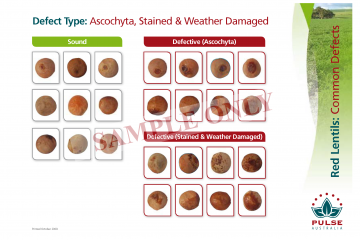
Red lentil: Ascochyta, stained and weather damaged defects
-
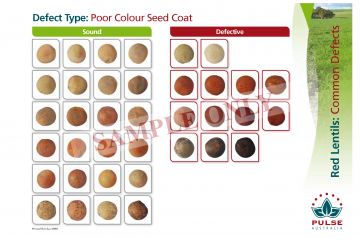
Red lentil: Poor colour seed coat defects
-
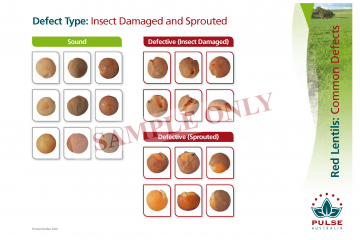
Red lentil: Insect damage and sprouted defects
-
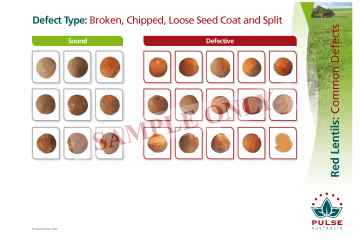
Red lentil: Broken, chipped, loose seed coat and split defects
-
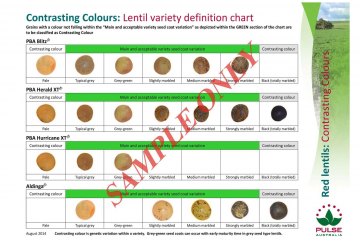
Red lentil: Contrasting colours – lentil variety definition
Australian pulse variety guide
The Australian Pulse Variety Guide 2021 provides details of the grain traits of all chickpea, faba bean, field pea, lentil and mungbean varieties grown in Australia, both current and past. This guide demonstrates the tremendous improvement in grain quality achieved by Australian pulse plant breeders over the past three decades.
Pulse Breeding Australia (PBA) was a world class Australian breeding program that delivered highly adapted chickpea, field pea, lentil, faba bean and lupin varieties to growers across Australia from 2006 to 2019. The breeding teams for each crop achieved higher yielding varieties with improved adaptation and disease resistance, while improving grain quality to match the requirements of our export markets. Following the closure of PBA, Grains Research and Development Corporation (GRDC) along with the lead agency involved in each PBA crop, remains committed to delivering improved, high value pulse varieties to Australian growers.
Chickpea Breeding Australia (CBA) is a joint venture with NSW Department of Primary Industries (NSW DPI) and GRDC, based at Tamworth, NSW. Lentil and field pea breeding is through Victorian Department of Jobs, Training and Regions at Horsham, with GRDC investment. Faba bean breeding is through Adelaide University (Southern Regions) and Sydney University (Northern Regions, Narrabri), with GRDC investment.
Grains Innovation Australia (GIA) a private company breeding lentils and field peas.
Plant breeders in the National Mungbean Improvement Progam (NMIP) fulfil this role for mungbean varieties. The NMIP is a collaborative initiative between GRDC and Department of Agriculture and Fisheries (DAF), Queensland focusing on the delivery of superior mungbean varieties for Australian growers and superior quality for the marketplace.
Australian Grain Technologies (AGT) conducts commercial lupin breeding in Western Australia through germplasm licensing arrangements established with Department of Primary Industries and Regional Development (DPIRD) and GRDC in 2015.
The details provided in this publication for each pulse variety are:
- year of release
- seed weight, expressed as grams per 100 seeds
- seed coat colour (for lentils)
- seed shape (for lentils)
- primary production region

